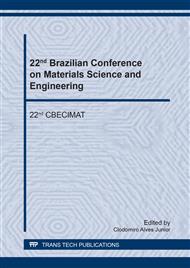p.224
p.230
p.236
p.241
p.248
p.254
p.258
p.264
p.270
Analysis of the Influence of Injection Process Parameters of Polymer Blends from Printers
Abstract:
Among the 40 million tons/year of e-waste discarded in the world, the recycling of polymers depends on the correct separation in disassembly as well as control of fluidity during processing. The objective of this study is to analyze the feasibility of HIPS blends recycling with other main polymers present in printers, through the analysis of the influence of pressure and speed parameters of injection to subsequently perform tensile tests for mechanical characterization. For this purpose, post-consumption polymers from disassembled printers were separated for analysis and comparison of HIPS-90%/PS-10% blend with HIPS-100%, which were injected into a mold with geometry of test specimens for tensile test, complying with ASTM standard D638-14, employing variations in pressure and speed and maintaining constant temperature. To identify the influence of levels of pressure between 45 and 60 bar and speed between 45 and 60 mm/min in yield point and elongation of the material a two-way ANOVA without replication was applied. When comparing the different levels of pressure and speed considered and evaluated in relation to the material composition, there were no significant differences between the levels, for both yield strength and for elongation. It was verified a variation on the mechanical properties of the PSHI and PS blend in relation to the pure PSHI, probably due to the amount of brominated flame retardants and elastomers present in PSHI from printers.
Info:
Periodical:
Pages:
248-253
Citation:
Online since:
September 2018
Keywords:
Price:
Сopyright:
© 2018 Trans Tech Publications Ltd. All Rights Reserved
Share:
Citation:


